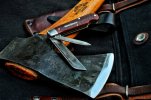- Joined
- Apr 7, 2006
- Messages
- 5,215
One of the things that drew me from modern folders to slip joints years ago was the look and soft feel that slipjoints take on over the years. Modern folders can certainly look beautiful after some use (I think of my Sebenzas that have the chamfer edges worn smooth) but most synthetic materials wear till they are worn out and thrown out. Most anything coated or painted loses value as it wears. The natural and oxidizing materials found on more traditional knives (slipjoints and fixed blades) tend to wear in a wear in a way that we can seldom describe but often makes they more personal and desirable to the owner. Things that are monolithic throughout can become more interesting as they wear: wood gets a groove, brass will have its edges worn off, and steel will pit and darken revealing a depth it didn’t have before but remain just as sharp at new steel.
Lately a lot of people force these patinas and this bothered me at first (like torn jeans do) but I started thinking the desire for a patina on something made of natural materials is possibly more built into our brains than we may think at first glance. I have been known to not rinse a knife immediately after cutting an apple from time to time... We only have to look at the Japanese term Wabi (the acceptance of natural beauty or imperfections from something handmade) Sabi (the rustic traits an item takes on over time) to see it is an old idea. Many old books include a description of a person’s knife as being heavily worn, because it communicates a lot about the person carrying the knife. Moving beyond knives: I recently toured an old log cabin museum from about 100 years ago and everything in this place was very clear that the owners of the objects appreciated something worn more than something new. This was a rather well-off man’s house and he choose to build things from tree roots and repeatedly use them for the sake of liking something natural over something you could buy. Things like a worn pipe, old carving tools he would pull the handles off of and replace with worn antlers, and of course his well-used knives. He could have replaced any of these things or built new ones but instead he would retain a handle from a carving tool (and replace the blade when worn down) because the handle was worn from his hand.
I wonder if this nostalgia for the natural wear of items goes back through all of history? The term Wabi Sabi is certainly older than American history. I understand most people in history used a couple tools their whole lives because they had to, but do you think these people appreciated the wear on their tools? The wear they put there or even their ancestors put there? Did ancient natives get a bit of joy seeing the worn groove in their long-bows from many arrows being shot or would an ancient hunter use the bone leather flesher his father gave him because it was worn smooth even though he was surrounded by new animal bones? What do you think?

Lately a lot of people force these patinas and this bothered me at first (like torn jeans do) but I started thinking the desire for a patina on something made of natural materials is possibly more built into our brains than we may think at first glance. I have been known to not rinse a knife immediately after cutting an apple from time to time... We only have to look at the Japanese term Wabi (the acceptance of natural beauty or imperfections from something handmade) Sabi (the rustic traits an item takes on over time) to see it is an old idea. Many old books include a description of a person’s knife as being heavily worn, because it communicates a lot about the person carrying the knife. Moving beyond knives: I recently toured an old log cabin museum from about 100 years ago and everything in this place was very clear that the owners of the objects appreciated something worn more than something new. This was a rather well-off man’s house and he choose to build things from tree roots and repeatedly use them for the sake of liking something natural over something you could buy. Things like a worn pipe, old carving tools he would pull the handles off of and replace with worn antlers, and of course his well-used knives. He could have replaced any of these things or built new ones but instead he would retain a handle from a carving tool (and replace the blade when worn down) because the handle was worn from his hand.
I wonder if this nostalgia for the natural wear of items goes back through all of history? The term Wabi Sabi is certainly older than American history. I understand most people in history used a couple tools their whole lives because they had to, but do you think these people appreciated the wear on their tools? The wear they put there or even their ancestors put there? Did ancient natives get a bit of joy seeing the worn groove in their long-bows from many arrows being shot or would an ancient hunter use the bone leather flesher his father gave him because it was worn smooth even though he was surrounded by new animal bones? What do you think?






